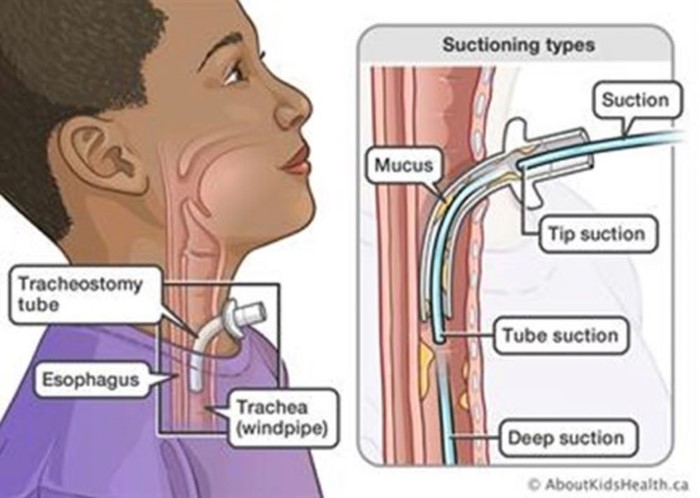In caring for a client who requires seizure precautions, the practical nurse (PN) should ensure the ready availability of equipment to perform which procedure?
Suction the trachea.
Insert a urinary catheter.
Apply soft restraints.
Insert a nasogastric tube.
The Correct Answer is A
- Seizure precautions are measures taken to protect a client who is at risk of having a seizure, which is a sudden and abnormal electrical activity in the brain that can cause changes in behavior, movement, sensation, or consciousness. Seizure precautions include providing a safe environment, monitoring the client's vital signs and neurological status, administering anticonvulsant medications, and documenting the onset, duration, and characteristics of any seizure activity.
- One of the potential complications of a seizure is aspiration, which is the inhalation of foreign material into the lungs, such as saliva, vomit, or food. Aspiration can cause choking, pneumonia, or respiratory distress. To prevent or treat aspiration, the practical nurse (PN) should ensure the ready availability of equipment to perform suctioning of the trachea, which is the tube that connects the mouth and nose to the lungs. Suctioning of the trachea involves inserting a catheter through the nose or mouth into the trachea and applying negative pressure to remove any secretions or debris from the airway.
- Therefore, option A is the correct answer, while options B, C, and D are incorrect.
Option B is incorrect because inserting a urinary catheter is not related to seizure precautions or aspiration prevention.
Option C is incorrect because applying soft restraints may not be necessary or appropriate for a client who requires seizure precautions, as they may interfere with the natural movements of the seizure or cause injury to the client.
Option D is incorrect because inserting a nasogastric tube is not related to seizure precautions or aspiration prevention.

Nursing Test Bank
Naxlex Comprehensive Predictor Exams
Related Questions
Correct Answer is A
Explanation
Choice A reason:
Increased haemoglobin is correct. level Epoetin alfa is a medication used to stimulate the production of red blood cells in the bone marrow, and it is often prescribed to treat anaemia. Anaemia is characterized by a decrease in the number of red blood cells or a decrease in the amount of haemoglobin, which is responsible for carrying oxygen in the blood.
The therapeutic response to epoetin alfa is an increase in the haemoglobin level. This indicates that the medication is effectively stimulating the production of red blood cells, leading to an improvement in the client's anaemia and overall oxygen-carrying capacity of the blood.
Choice B reason:
Increased platelet count: Platelets are involved in blood clotting and are not directly affected by epoetin alfa.
Choice C reason:
Increased neutrophil count: Neutrophils are a type of white blood cell involved in the body's immune response. Epoetin alfa primarily affects red blood cells and does not directly impact white blood cell levels.
Choice D reason:
Increased erythrocyte sedimentation rate (ESR): ESR is a non-specific indicator of inflammation in the body and is not directly related to the therapeutic response of epoetin alfa in treating anaemia.
Correct Answer is D
Explanation
A. This is incorrect because weight gain is not expected in clients who have COPD, as they often have difficulty eating and digesting food due to dyspnea and fatigue.
B. This is incorrect because a decrease in anteroposterior diameter of the chest is not typical of COPD, as the condition causes hyperinflation and air trapping in the lungs, leading to an increase in chest size and a barrel-shaped appearance.
C. This is incorrect because HCO3 24 mEq/L is within the normal range for blood bicarbonate levels, which are 22 to 26 mEq/L. Clients who have COPD often have chronic respiratory acidosis, which stimulates the kidneys to retain bicarbonate and increase its levels in the blood to compensate for the low pH.
D. This is correct because pH 7.31 indicates acidosis, which is common in clients who have COPD due to impaired gas exchange and accumulation of carbon dioxide in the blood.
Whether you are a student looking to ace your exams or a practicing nurse seeking to enhance your expertise , our nursing education contents will empower you with the confidence and competence to make a difference in the lives of patients and become a respected leader in the healthcare field.
Visit Naxlex, invest in your future and unlock endless possibilities with our unparalleled nursing education contents today
Report Wrong Answer on the Current Question
Do you disagree with the answer? If yes, what is your expected answer? Explain.
Kindly be descriptive with the issue you are facing.
